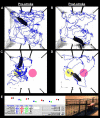An integrative multivariate approach for predicting functional recovery using magnetic resonance imaging parameters in a translational pig ischemic stroke model
- PMID: 33229718
- PMCID: PMC8178783
- DOI: 10.4103/1673-5374.297079
An integrative multivariate approach for predicting functional recovery using magnetic resonance imaging parameters in a translational pig ischemic stroke model
Abstract
Magnetic resonance imaging (MRI) is a clinically relevant, real-time imaging modality that is frequently utilized to assess stroke type and severity. However, specific MRI biomarkers that can be used to predict long-term functional recovery are still a critical need. Consequently, the present study sought to examine the prognostic value of commonly utilized MRI parameters to predict functional outcomes in a porcine model of ischemic stroke. Stroke was induced via permanent middle cerebral artery occlusion. At 24 hours post-stroke, MRI analysis revealed focal ischemic lesions, decreased diffusivity, hemispheric swelling, and white matter degradation. Functional deficits including behavioral abnormalities in open field and novel object exploration as well as spatiotemporal gait impairments were observed at 4 weeks post-stroke. Gaussian graphical models identified specific MRI outputs and functional recovery variables, including white matter integrity and gait performance, that exhibited strong conditional dependencies. Canonical correlation analysis revealed a prognostic relationship between lesion volume and white matter integrity and novel object exploration and gait performance. Consequently, these analyses may also have the potential of predicting patient recovery at chronic time points as pigs and humans share many anatomical similarities (e.g., white matter composition) that have proven to be critical in ischemic stroke pathophysiology. The study was approved by the University of Georgia (UGA) Institutional Animal Care and Use Committee (IACUC; Protocol Number: A2014-07-021-Y3-A11 and 2018-01-029-Y1-A5) on November 22, 2017.
Keywords: Gaussian graphical models; behavior testing; canonical correlation analysis; gait analysis; ischemic stroke; magnetic resonance imaging; pig model; principal component analysis.
Conflict of interest statement
None
Figures




Similar articles
-
Magnetic Resonance Imaging and Gait Analysis Indicate Similar Outcomes Between Yucatan and Landrace Porcine Ischemic Stroke Models.Front Neurol. 2021 Jan 21;11:594954. doi: 10.3389/fneur.2020.594954. eCollection 2020. Front Neurol. 2021. PMID: 33551956 Free PMC article.
-
Human Neural Stem Cell Extracellular Vesicles Improve Recovery in a Porcine Model of Ischemic Stroke.Stroke. 2018 May;49(5):1248-1256. doi: 10.1161/STROKEAHA.117.020353. Epub 2018 Apr 12. Stroke. 2018. PMID: 29650593 Free PMC article.
-
Characterization of tissue and functional deficits in a clinically translational pig model of acute ischemic stroke.Brain Res. 2020 Jun 1;1736:146778. doi: 10.1016/j.brainres.2020.146778. Epub 2020 Mar 16. Brain Res. 2020. PMID: 32194080 Free PMC article.
-
Neuroimaging in cerebrovascular disorders: measurement of cerebral physiology after stroke and assessment of stroke recovery.Semin Nucl Med. 2003 Jan;33(1):56-76. doi: 10.1053/snuc.2003.127293. Semin Nucl Med. 2003. PMID: 12605357 Review.
-
Recent Advances in Leukoaraiosis: White Matter Structural Integrity and Functional Outcomes after Acute Ischemic Stroke.Curr Cardiol Rep. 2016 Dec;18(12):123. doi: 10.1007/s11886-016-0803-0. Curr Cardiol Rep. 2016. PMID: 27796861 Review.
Cited by
-
Determining underlying influences of data variability in the novel object recognition paradigm as used with young pigs.Front Behav Neurosci. 2024 Aug 27;18:1434489. doi: 10.3389/fnbeh.2024.1434489. eCollection 2024. Front Behav Neurosci. 2024. PMID: 39257566 Free PMC article.
-
Validating an updated protocol for the novel object recognition task in young pigs.Front Behav Neurosci. 2025 Mar 31;19:1480389. doi: 10.3389/fnbeh.2025.1480389. eCollection 2025. Front Behav Neurosci. 2025. PMID: 40231117 Free PMC article.
References
-
- Alexander LD, Black SE, Patterson KK, Gao F, Danells CJ, McIlroy WE. Association between gait asymmetry and brain lesion location in stroke patients. Stroke. 2009;40:537–544. - PubMed
-
- Attyé A, Boncoeur-Martel MP, Maubon A, Mounayer C, Couratier P, Labrunie A, Le Bas JF. Diffusion-Weighted Imaging infarct volume and neurologic outcomes after ischemic stroke. J Neuroradiol. 2012;39:97–103. - PubMed
-
- Benjamin EJ, Muntner P, Alonso A, Bittencourt MS, Callaway CW, Carson AP, Chamberlain AM, Chang AR, Cheng S, Das SR, Delling FN, Djousse L, Elkind MSV, Ferguson JF, Fornage M, Jordan LC, Khan SS, Kissela BM, Knutson KL, Kwan TW, et al. Heart Disease and Stroke Statistics-2019 Update: A Report From the American Heart Association. Circulation. 2019;139:e56–528. - PubMed
Grants and funding
LinkOut - more resources
Full Text Sources
Other Literature Sources
Research Materials

